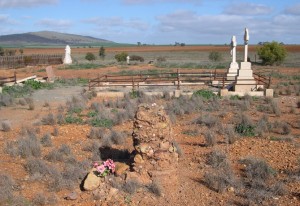Building techniques and materials indicate the period of building:
- Early homes for miners and shepherds were often made of Callitris pine logs filled in with mud (wattle and daub),
- The lack of dense stands of timber in most of South Australia meant that builders used local stone. South Australian stone buildings last longer than those in more forested states where timber was the main building material.
– Building styles give clues to the country of origin of builders:
- Square-section smelter chimneys were built by Welsh miners
- Round section smelter chimneys were built by Cornish miners.
– Use of mortar required lime burning, so many structures used “dry stone walls”: the Pichi Richi railway was built by Cornish stone masons with Chinese labour between 1879 and 1882.
– Old Wilpena Station has been preserved within Flinders Ranges National Park to explain the use of buildings and pastoral equipment from the 19th and 20th centuries. A trail allows visitors to study interpretations signs which explain the station relics and artefacts. [download Old Wilpena Station pdf here]. PDF file has been sent together with this one]
– Cemeteries provide particularly useful information about the post-settlement history of the Flinders Ranges. The tombstones also show the style and rate of weathering of rocks in desert climate.

– Bottle dumps can be used to gauge economic viability of mines:
- The Western Australian gold fields were wealthy. Finds there include imported spirit bottles, perfume bottles and ceramic pots.
- In the Flinders Ranges mines were poorer and miners made do with beer and canned meat.
– Dating old settlements: o Hand made nails: up till 1905
- Corked & wired beer bottles with recessed base: up till WW1
- Crown seal bottles: after WW1
- Hand-made openings to bottles: up to WW1
- Bottle seams all the way to the lip: after WW1.
Based on South Australian Museum 2008 Mountains of Memory Oraparinna
